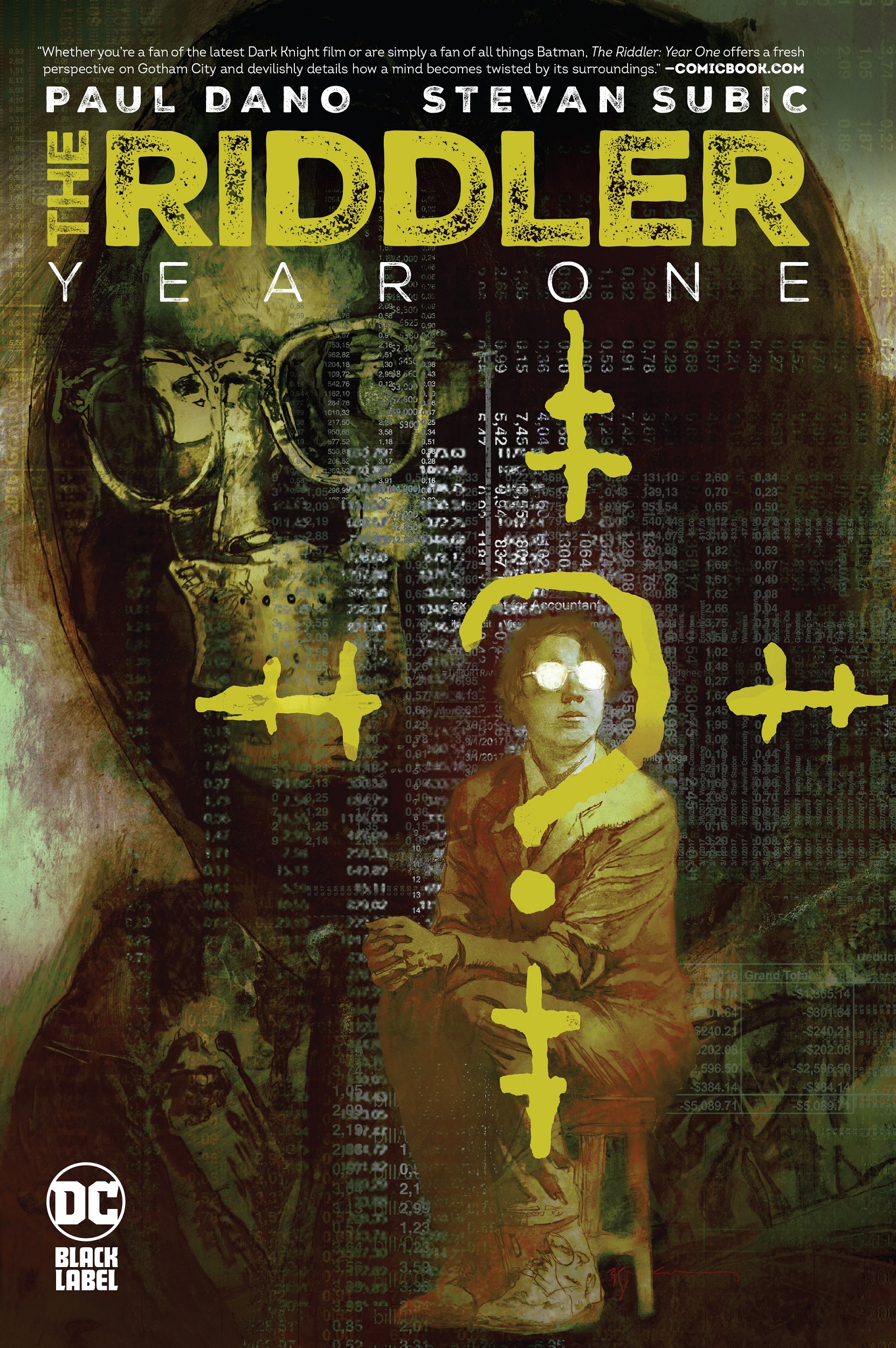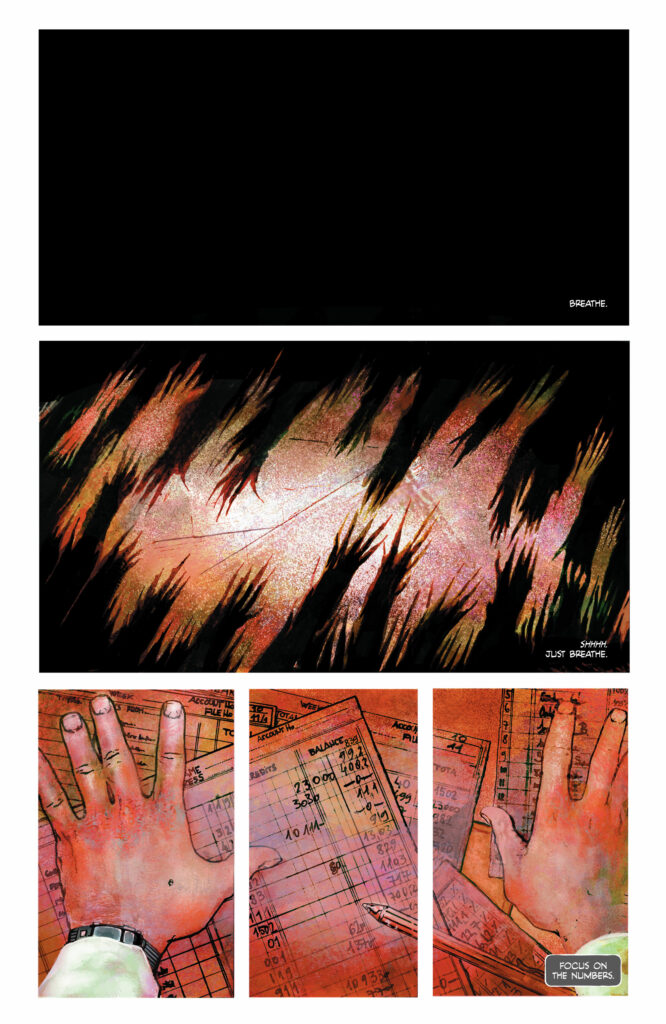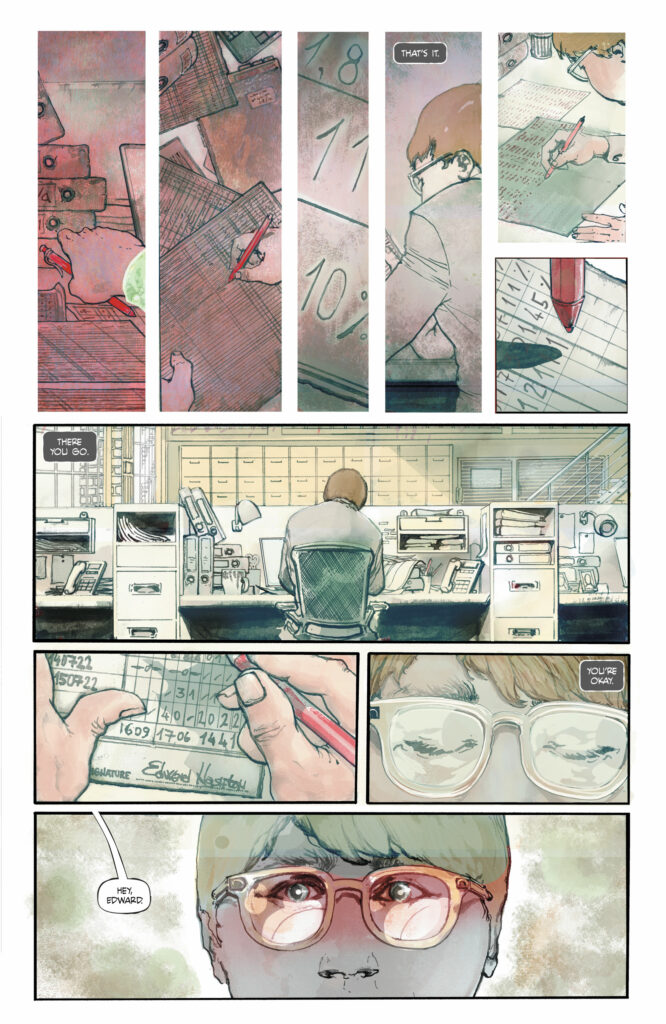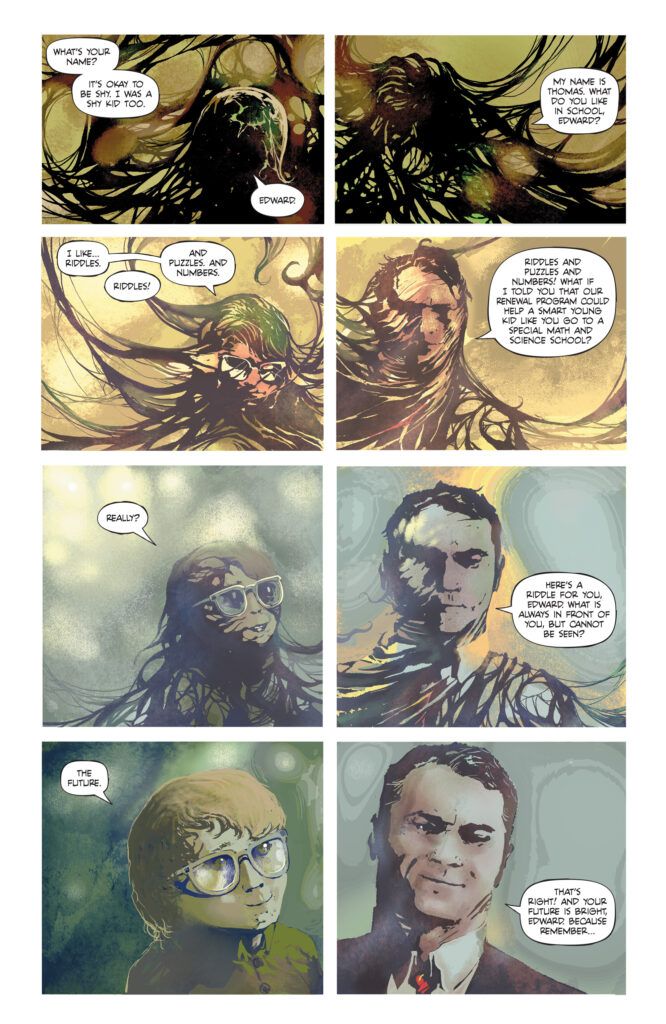The Riddler: Year One

Artist: Stevan Subic
Letterer: Clayton Cowles

Review by Steven Lee Sharpe
Occasionally, a new comic launch almost sells itself, due to the interest it generates. The Riddler: Year One is a perfect example of this. The story’s written by Paul Dano, the actor who played the character in The Batman (2022). DC had me there already, when they announced the series, back in March.
The question wasn’t so much if I was curious enough to take a look, it was more like, what does Dano have to say about the Riddler, and how proficient will he be at writing a comic?
The fact that Dano is something of a method actor is well documented; he likes to research his roles thoroughly and think carefully about the character’s back story. For the Riddler he also read a lot of comics; Batman comics, non-Batman comics, books about comics… he even listened to podcasts about comics. One day during production of The Batman, Dano was talking to the movie’s writer/director Matt Reeves about the images he’d created in his mind when thinking about how Edward Nashton became the Riddler. Reeves was so impressed that he engineered a meeting between Dano and DC to talk about turning those images into a comic.
This means that Dano came to the project not just with a rigorously thought-out idea of how the Riddler should be portrayed as a character, but he’d explored the comics medium so thoroughly that he understood the importance of images and telling the story in a visual way. This respect for both character and the medium shine through in this book.
As you might expect, from his close involvement in the character, Dano writes Edward Nashton sympathetically. He’s shy, neurotic, and good at his job; analyzing accounts for financial irregularities. He’s also met with rudeness when he tries to be nice on the train and is taken advantage of by his boss. However, there’s clearly another side to him. Through the character’s interior monologue, we learn how Edward’s trying to keep a depressive side of his nature at bay. This is where Dano shows maturity as a writer because he allows the art to convey the inner darkness of Nashton’s character.
In fact, considering Paul Dano is the big name here, illustrator Stevan Subic, with his first work for DC Comics, is every bit as much the star of the show. Evoking a feeling of Bill Sienkiewicz with his watercolor and expressionistic style (is it a coincidence that Sienkiewicz has contributed covers to the series?) there’s so much to admire here.
The switches in style from, for example, the clear linework in a courtroom scene, to the looser expressionism for when we’re seeing the world through Edward Nashton’s eyes. We get glorious single panels, such as an image of Gotham at night, with bats flying over rough waters lashing against the harbor and the image of Nashton kneeling by two unconscious bodies, evoking the memory of the young Bruce Wayne in Crime Alley. The claustrophobic close-ups and the sickly-looking color choices for the office scenes. Subic even manages to capture Paul Dano’s likeness without it looking like he’s copied stills from the movie.
What makes this book stand out is that, not only is the story told through Edward Nashton’s eyes, but this perspective is often distorted into his nightmarish version of reality. Subic then paints a world that veers between reality and Nashton’s impression of it. As well as the recurring black tendrils, nauseating colors surround him, and faces suddenly change into horrific monsters. On one page a large question mark looms over Nashton’s head, made up of pictures of him at different ages, and smudges that look like veins or the vascular system of a leaf.
The chilling imagery counterbalances the sympathetic way that Dano writes the character. Having spent his whole life bullied and abused, Nashton’s simply just trying to do the right thing. At the same time, just as Bruce Wayne did, he finally has a purpose in his life, to use his extraordinary analytical skills.
Will it be… that this brain will finally get put to use?”
If you read the script without the images, particularly in the first half of the collection, you could think that you’re reading the origin of a hero. Thanks to Dano and Subic’s working relationship however, the pictures tell a very different story. Put together, the results make the tale more of a tragedy.
The irony is that, all the while, Edward’s desperate for help from Batman. Bruce Wayne wanted the image of the Dark Knight to strike fear into the hearts of criminals, so what does it mean when Edward sees hope and comfort in the powerfully drawn image of Batman outside his window? At his lowest point, Edward finds inspiration in the image of the cowl to continue his investigations.
Dano has said that he spent a lot of time talking with Subic about how they would tell Edward’s story, which has led to a rich partnership that has seen moments of juxtaposition, where Dano’s been able to write something suggesting a lighter tone whilst allowing Subic to draw out the horror. For example, there’s a lovely moment where Edward, who is largely mute by choice, meets Thomas Wayne and opens up to him (revisiting a scene shown briefly in a previous chapter). However, Subic includes an onlooking teacher’s face in the panels which slowly distorts into something demonic.
This fourth chapter addresses the evolution of his feelings towards the Waynes and is crucial in giving insight into his personality. In fact, it practically works as a standalone story, showing his past in such a splintered way that it turns the Riddler’s mind itself into a riddle. The question is whether a whole chapter devoted to a flashback holds up the overall plotting of the story arc.
Certainly, when collected into a graphic novel it may feel like a slight a detour, but with this story, Dano’s solving two mysteries about the Riddler; the first is how Edward came to be as we find him in the movie, at war with the Waynes, Falcone, and pretty much anyone in power in Gotham. The second is to show what crazy-paving path led Edward’s mind becoming so uniquely twisted.
The Riddler: Year One is is not your average comic. In fact, for large parts of the fifth chapter, it challenges the definition of a comic book completely, because it reads like a journal, albeit one written by a homicidal maniac. This is where Edward Nashton finally formulates his plot to become The Riddler.
On what looks like pages of financial auditing form templates, we get to read Nashton’s thoughts written in scratchy, messy handwriting. His mind has lost all perspective now, unable to contain his delusional internal logic as he takes an initially righteous cause and turns it into a terrorist crusade.
Each page of chapter five is littered with either “photographs” that Nashton’s taken, maps, newspaper clippings, or unsettling doodles. Subic’s visual storytelling is remarkable. He has turned The Riddler: Year One into a horror comic, even though the demons are imaginary. There’s an extraordinary page showing Nashton kneeling at the feet of Batman who’s surrounded by a bright white light, like an angel.
Narratively, this was always going to be a story without an end, as it’s ultimately the set-up to the larger tale of Matt Reeves’ film. Even Edward Nashton’s revenge on those who inspired his wrath has to wait until the movie because Batman has a role in it. The question was whether Paul Dano could make Edward Nashton’s journey worth telling in its own right and if it would bring more depth to The Batman movie.
Personally, I think the answer is a resounding “Hell, yeah” on both counts. The Batman had a complex narrative that involved Batman simultaneously trying to uncover the identity of The Riddler through his crimes, whilst also recognizing that those crimes were actually uncovering the illegal activities of those in power. It’s all very well seeing the likes of Falcone and the other big players in this web of corruption get caught out, but it was largely thanks to Edward Nashton’s work that this happened. Of course, we don’t want to give praise to a homicidal maniac, but his investigation, the smaller players involved, and the people tragically caught up in all of it, give us a story worth telling that adds nuance to what follows.
Then there’s Nashton himself. After reading The Riddler: Year One, it’s impossible to write off the character in the film as just another villain. He had a tragic background of neglect and disappointment, yet genuinely tried to do the right thing when he discovered wrongdoing in his role as a forensic accountant.
Dano is careful not to create excuses for the character’s behavior, just the reasons for it, and Subic’s artwork does an excellent job of constantly reminding us that there was a darkness in him waiting for the opportunity to grow. Read this book and, when you watch the movie again, I promise you won’t see The Riddler in quite the same way.
Conclusion
Although a prequel to The Batman, The Riddler: Year One is closer in spirit to the Joker movie, as it also depicts a troubled individual reacting badly to the dark side of Gotham. Although it’s essentially a character study, Paul Dano has shown considerable restraint in his writing by allowing illustrator Stevan Subic to present the world through Edward Nashton’s eyes. The stirring imagery truly elevates the great writing.
Primarily, this prelude to the film shows us how a man working at an accountancy firm unraveled a hidden tapestry of crime and corruption within big business and the running of Gotham City, and how this discovery turned him into a vengeful terrorist. Given the small amount of time Nashton got on-screen, it’s also a chance to put him under the microscope. Aren’t we always fascinated to find out what makes the bad guys tick? In Nashton’s case, the story’s a tragic one; we have a man struggling with mental demons who tries to do the right thing when he uncovers illegal activities. This story finds our sympathies balance out for a man who eventually becomes a villain.
This stunning hardcover book collects all six issues and covers and an introduction by writer, Paul Dano. The back of the book features a beautiful four page section of art, sketches and thoughts from the artist, Stevan Subic, as well as a 17 page gallery featuring all the variant covers.
$29.99
Released on Nov 21, 2023 – Available to pre-order NOW
ISBN 9781779523068
Images Courtesy of DC Entertainment. Review Copy Courtesy of Penguin Random House





